What are browser hijackers?
A browser hijacker is a type of malware that can alter your default homepage and search engine. It can also automatically download viruses without the user’s consent.
Additionally, it also downloads various sorts of malware, such as spyware and ransomware, which can severely damage your computer.
Configurations that browser hijackers change
Browser hijackers change your default search engine to a different one to track and collect information about you.
The malware can record your keystrokes and everything you input on text fields, including personal information, passwords, banking information, and other vital information.
It can alter the new tab page and home page of the web browser. Furthermore, it can expose users to potentially dangerous websites that might harm their devices and eventually result in the installation of malware.

The browser hijacker can also change the search results provided by trustworthy search engines like Google. They will alter the search results to display unwanted websites at the top of the search queries rather than the organic search information that will benefit the users.
In addition to that, browser hijackers can also modify the browser to ensure that the malware can not be removed. It is a very troublesome issue given that it makes it more difficult to get rid of the malware especially if the user is not tech savvy.
Moreover, browser hijackers alter a lot of browser configurations, which slows down the loading of web pages due to the process it does of monitoring the web activity.
The constant display of pop-up advertisements may also be irritating, therefore do your best to avoid getting infected with this malware.
Why do cybercriminals utilize browser hijackers?
They can profit through this marketing since hackers force individuals to use a different search engine. They get paid for forcefully pushing a third-party search engine to users.
In addition to changing the search engine, they also alter the search results so that every time you use the search engine, a different set of results will be displayed, which will be unhelpful and unrelated to the user’s query.
It will show unwanted websites that are not even associated with your search instead of the results that you expect. Hackers can make money by displaying advertisements above the results.
You could also get redirected to search engines like Bing and Yahoo. Even though those platforms are completely legitimate, malware actors push web users’ browsers to utilize them because the aforementioned search engines reward users for using their platforms.
Cybercriminals set up your browser to use the following search engine but they adjust the reward to be delivered to their accounts.
In some cases, they also create a fake search engine themselves. Hackers do this to steal information about an individual without their awareness. The data stolen will soon be sold to advertisement businesses, which is another way for hackers to gain money.
And since they control your browser, they also can monitor and keep track of your web activities. This may include several important pieces of information about you. Cybercriminals can use this data for illicit activities like selling it to other criminals on the dark web.
They will use all methods necessary to carry out their illicit activities as long as it will allow them to generate income. Browser hijacking is just one of the numerous techniques used by hackers to make money, and it already demonstrates how harmful malware is and how it may cause problems in ordinary people’s lives.
How does the computer get infected with a browser hijacker?
Downloading cracked software might lead to your computer being infected with a browser hijacker given that you have probably downloaded a bundled software.
This is particularly harmful since it may be downloaded and installed accidentally. It is more likely to be shown as a bonus that is related to the current installation. This may look puzzling to normal users, which can lead to the installation of unwanted software.
Torrenting movies and applications are also unsafe since there is a possibility that the content that’s being shared might be infected with malicious software.
An example of this is when a specific video file doesn’t play, it then tells you that you need to download a specific software program to play the movie. Users are tricked into downloading the browser hijacker through this approach.
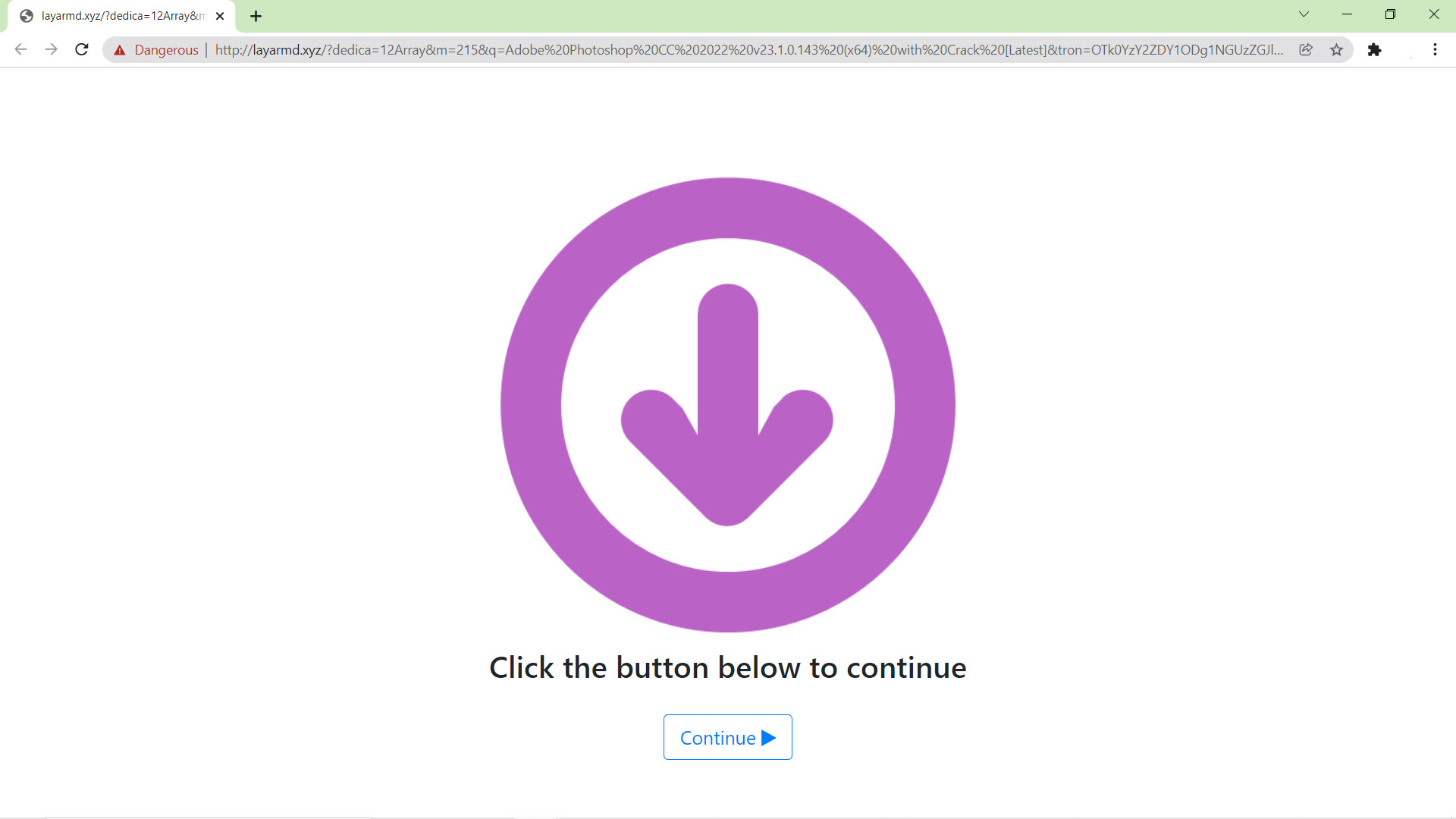
Browser hijacking can have several causes, including drive-by downloads. It occurs when malware gets downloaded without the user’s knowledge or consent. This type of malicious behavior frequently occurs on websites that are compromised or owned by hackers.
Installers that promote this type of malicious software have the potential to infect users. There’s a chance that a harmful program was installed in addition to the main application that the user did install. This is very harmful since the average user may unintentionally install the browser hijacker.
Another technique that cybercriminals make use of to infect a user’s device is malvertising. This occurs when hackers pay an advertising network to distribute a malicious ad throughout the internet.
Once a user encounters this advertisement, they run a malicious code that can identify the browser’s vulnerabilities and use this information to install the browser hijacker onto the victim’s computer.
Examples of browser hijackers found on the web
Numerous innocent internet users have been infected by all the browser hijackers that are present online. Therefore, our team makes every effort to find these browser hijackers and assist people who have become infected with this malware. Below are some of the browser hijackers that we have found.
The newly discovered browser hijacker
The following is a list of new browser hijackers discovered by our team. Since browser hijackers are being developed at a steady pace, we make sure to detect these newly programmed malicious programs for a better and safer browsing experience for everyone.
| Recently Found Browser Hijacker Threats |
|---|
 Searchboss.com
Discovered in July 5, 2023 by Millan Nava Searchboss.com
Discovered in July 5, 2023 by Millan Nava
|
 Dragonorders.com
Discovered in June 16, 2023 by Millan Nava Dragonorders.com
Discovered in June 16, 2023 by Millan Nava
|
- 1
Users must exercise caution when exploring the internet to avoid getting infected with the new browser hijackers that have recently been detected. So stay away from suspicious websites, and thoroughly check everything you download from the internet.
Browser hijacking via legitimate search engines (Bing & Yahoo)
As we have previously mentioned, even though Bing and Yahoo are two trustworthy search engines, hackers are using them since they offer reward points to users that use their search engines.
Cybercriminals employ a variety of techniques to forcefully install them onto a user’s device. Once it’s installed, your search engine will now be changed to either Bing or Yahoo.

Once the search engine is now different, users can now earn reward points for every search they carry out. However, this is not the case, hackers configured it so that every point that the user generates will be automatically directed to the hacker.
In addition to Bing and Yahoo, there may be other legitimate search engines that are being misused. That is why users ought to exercise caution when browsing the internet.
ChromeLoader malware
One of the most harmful browser hijacker viruses is called ChromeLoader. It takes control of the user’s browser and adds undesirable extensions.
Additionally, it could cause the browser to perform harmful actions, primarily changing the search engine, and making sure that the extension installed is difficult to delete.
It has a cog wheel icon and appears as a web plugin. Each time this threat is updated, it changes and takes on a variety of names. The aforementioned extension has been used in numerous different ways.
Some of the most recent versions of the harmful ChromeLoader virus, which noticeably modifies the extension’s name are: Ring, Book, Blanket, Couch, and Drag. With such browser extension names, they are typically concealed in the browser.
Once the malware extension is installed, the search engine will be changed to Searchokay.com, Gosearches.gg, and Searchmenow.gg. The interface of these domains would be the same as the rest.

These extensions are the reason why the search engine has changed, but you can’t just fix it because you can’t get rid of the extension. When you open the browser again after trying to delete it, it will eventually reappear.
In addition, one of the symptoms of the newer versions was a CMD popping up with a domain popping up such as Appyrinceaskeda.com, Qasforsalesrepr.info, and Ubeliketheap.com.
One of the most dangerous plugins that have ever been present on the browser is the ChromeLoader extension, which gets its source from drive-by downloads and pirated/torrent applications.
Browser hijacker search groups
Meanwhile, there are also things called browser hijacker search groups, they are primarily responsible for the creation of malware of this kind.
This type of malware may have many different variants with the same design and is only created by one developer.

The browser hijackers Oltly.com, Shofast, and Searchel are an example of that; they were created by the same developer. Since they were made by the same programmer, it is possible that they were all distributed through the same method.
Even though almost other browser hijacker was created by different cyber criminals, they all share the same objective, which is to make money.
Hackers participate in these illegal activities, such as altering your search engine or rerouting your browser to a different website, all for financial gain.
Poshukach and Go-go.tech virus
Two instances of the same malware and webpage design but each with a different name, have been discovered. It installs an extension and changes your entire browser, including your search engine, home tab, and new tab.
Both of these browser hijackers are a serious risk to users since they may unintentionally download them, which could result in the installation of malware, exposure to online scams, and other malicious activities.
Image of Poshukach:
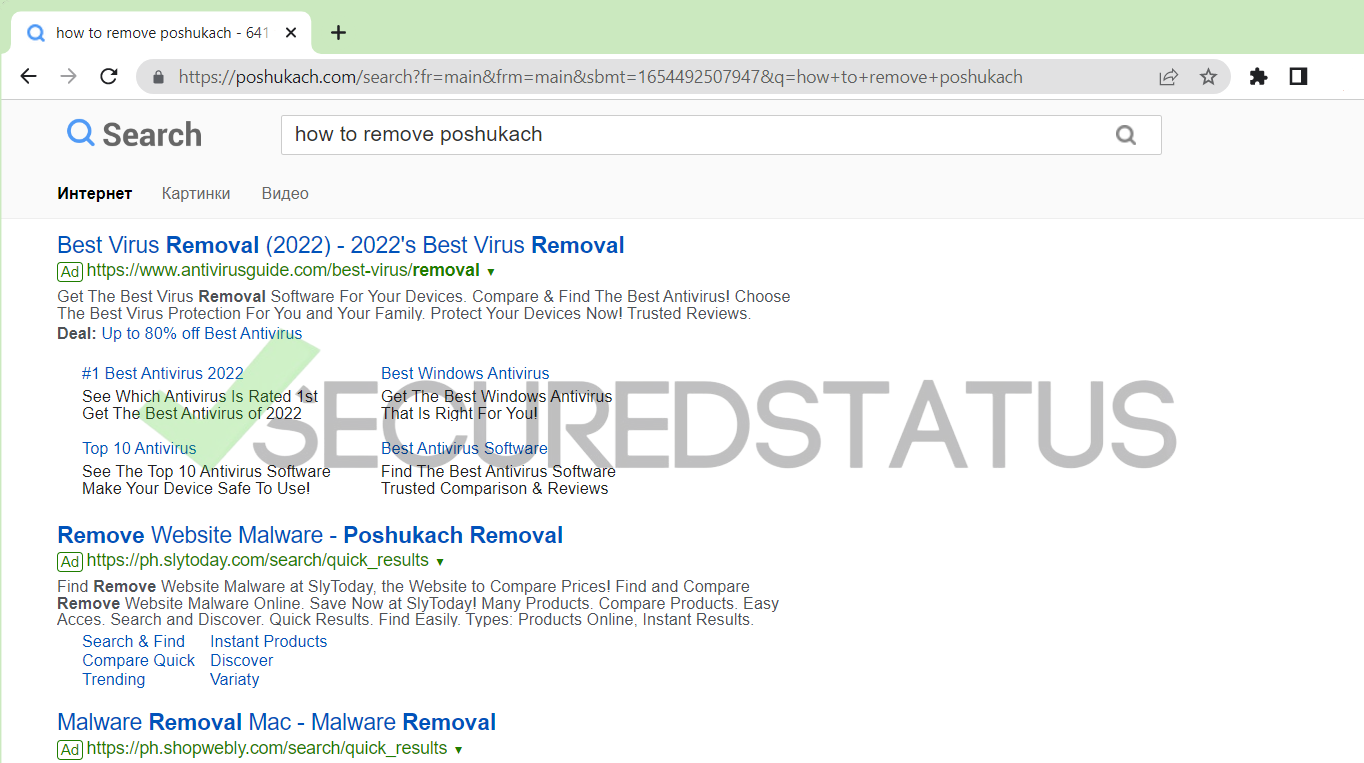
Image of Go-go.tech:

It is commonly discovered when installing software from unknown and illegitimate sources. These browser hijackers can also be installed through compromised websites or websites owned by hackers.
Redirection browser hijacker
Certain browser hijackers, like Search-fetch.com and Search-good.com, are different from the others. Rather than changing your search engine and other elements, it only redirects you to a different website.
Whenever you use the URL to perform a search, you will always be redirected to Bing or Yahoo, and show the results there instead of on Google.

Since the mentioned websites pay users for using their search engine, hackers can profit from this by configuring it, making it so that the hackers will receive the points, rather than the user.
Despite differences from other browser hijackers, it can still cause problems for users given that it can be very difficult to get rid of. If a malicious program has been installed onto your device, it could have been downloaded through that software.
PC App Store browser hijacker
PC App Store is an unknown website where users can download games, and while it seems to be a completely legitimate application, it gets installed in the computer without the user’s knowledge, much like adware or PUA.
This program will most likely be installed through the use of software bundling, as it appears as a bonus offer next to a free application, which most people will install mistakenly.

Once this software is installed, all of your search requests will be routed to a different website called Search.pcapp.store. The installation of this browser hijacker is primarily caused by the PC App Store.
Browser Hijacker Removal Procedure
The methods provided below will assist you in removing any potential malware, trojans, rootkits, and viruses from the computer system, in addition to getting rid of the malicious browser hijacker.
Removing malware from the system and the browser should be thorough and carefully executed; therefore, please follow every step provided.
We made the instructions below easy to understand so non-tech-savvy users can still remove the browser threat without needing help from tech support or a computer technician.
Step 1: Reset the browser to its default settings
Resetting the browser includes complete reversal and wiping out history, homepage settings, default search engines, and browser permissions, which may be used by cybercriminals to hijack the browser.
In addition, the browser reset does not include the favorites tabs, bookmarks, or saved passwords in some cases. To reset your browser to its default settings, please follow the steps below for the browser you are using.

Remove browser hijacker from Google Chrome
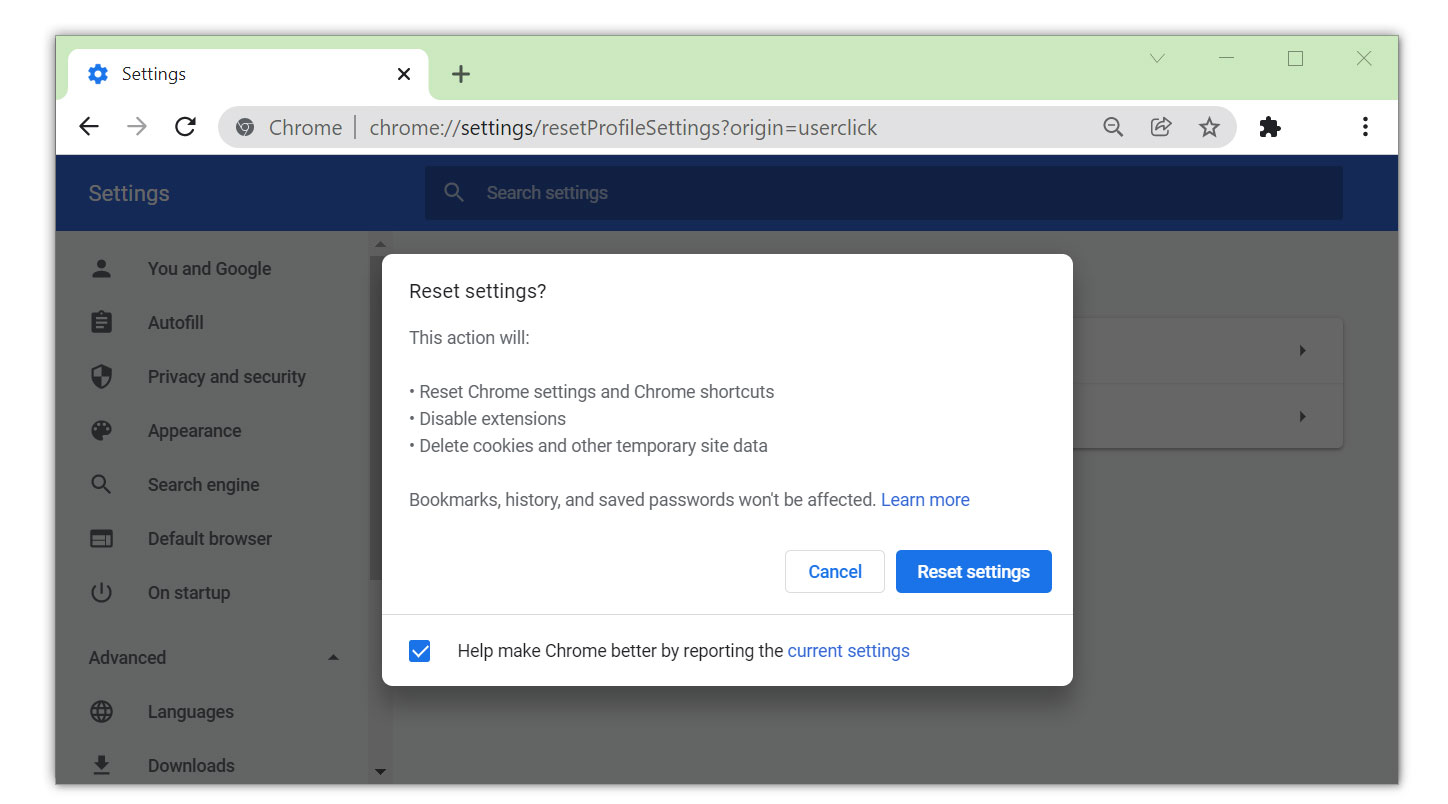
1. Open the Google Chrome browser and click the three dots in the upper-right corner of your screen to access the drop-down menu.
2. From the menu presented, select the Settings button, then click the Advanced menu on the left side of the screen from the settings.
3. On the drop-down menu presented on the screen, select Reset and Clean up.
4. Click on the Restore settings to their original defaults.
5. Then a small confirmation window will appear; click the Reset Settings.

Remove browser hijacker from Mozilla Firefox
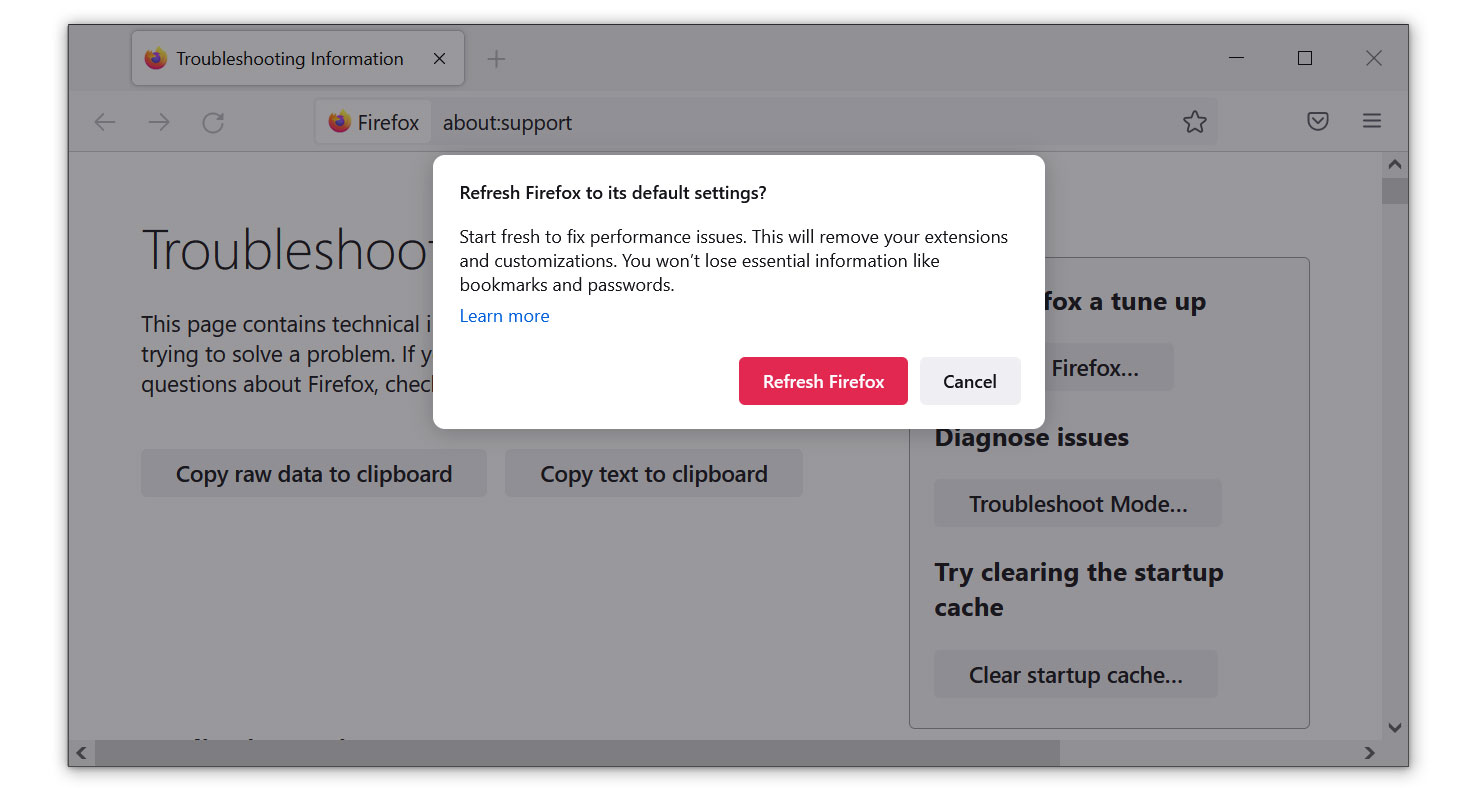
1. Launch the Mozilla Firefox browser, then open the menu by clicking on the three horizontal lines located in the upper-right corner.
2. Navigate down and click Help, then select More Troubleshooting Information from the options given.
3. Select the Refresh Firefox button. Then click Refresh Firefox on the confirmation window that appears.

Remove the browser hijacker from Microsoft Edge
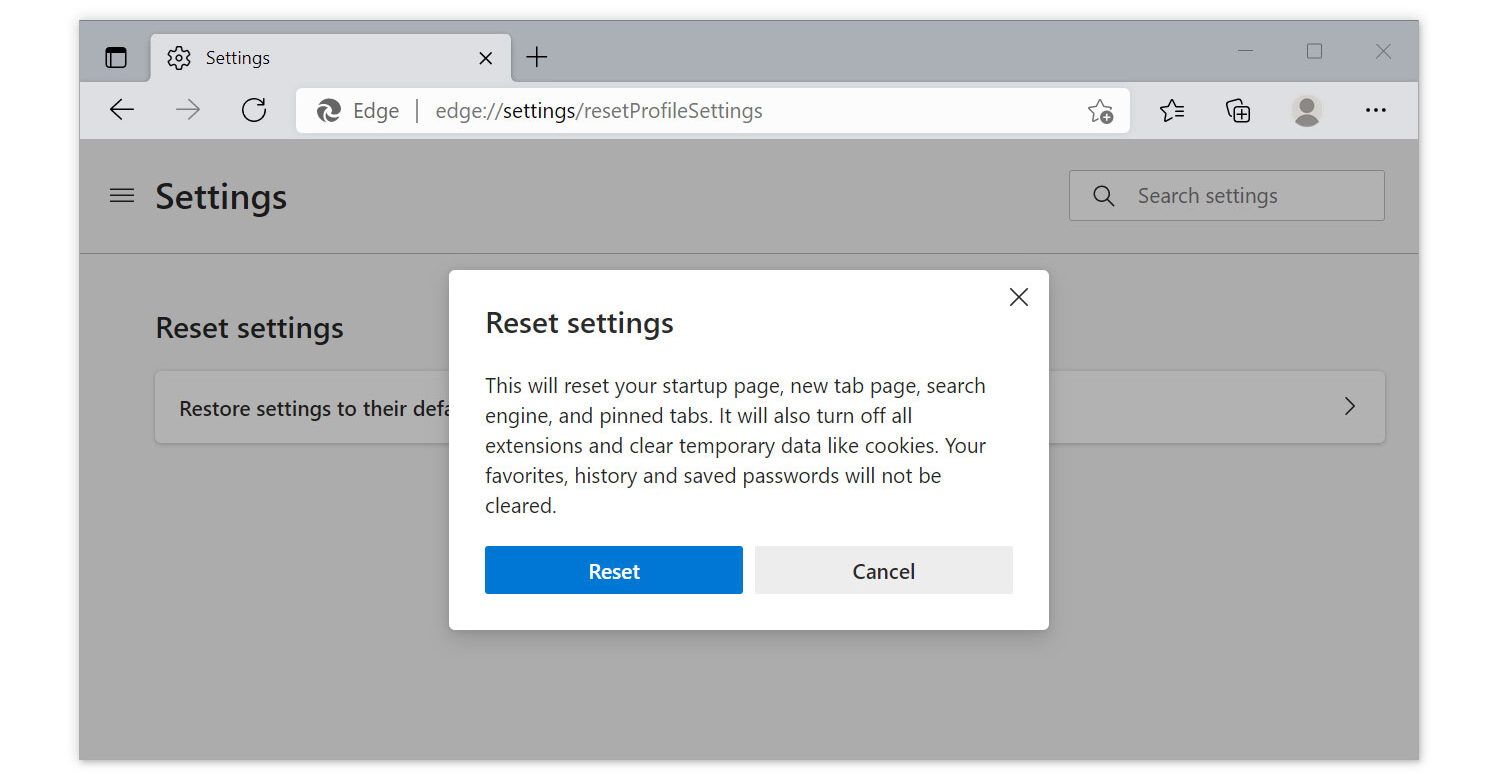
1. Run Microsoft Edge on the computer and click the three-dot icon in the upper-right corner.
2. Click on the Settings button from the drop-down menu.
3. Find and click Reset Settings from the left sidebar. Then click on the option Restore settings to their default values.
4. A warning window will appear, telling you that you are about to reset the browser. Click Reset, and the browser should return to its default settings.
The configurations added by the browser hijacker have all been removed, and your browser has now been entirely reset to the settings it had when you initially installed it. You can use your browser with complete security now. Rest assured that the redirections won’t resurface again.
Step 2: Uninstall unwanted programs from the computer
Adware, often known as advertisement-supported software, can also be the main culprit behind most browser-related issues, which can include the installation of a browser hijacker. If the problem persists even after the browser has been reset, adware may have been installed on the system.
Many users may not know this, but adware can automatically configure the browser to show pop-ups and redirect web pages. When it detects that users have removed the current configuration, it will immediately replace it again without requesting the users’ consent.
How will I know what to uninstall?
Giving the exact name of the malicious program may be complicated, but there are ways to make it easier to detect it. One of which is to simply remove all unknown programs you do not recognize or think you have not installed. You may have applications that you don’t even know the use for; that is a sign that they can be malware.
Unless it is a system process, which you can see by checking the developer of the application, some trojan viruses also use recognized and legitimate names to obfuscate their programs. If the publisher name or source of the program is unknown to you, it is best to uninstall it.
Another thing to do is to look at the version number; the majority of adware and dangerous programs will have version 1.0 because they don’t need to be updated and are merely running as background applications.
To remove malicious programs from your computer, we have provided two ways to do so: one is through normal uninstallation, and if that does not work, we also provide an advanced uninstall method to make sure it will be removed without issues.
Remove browser hijacker via Control Panel
The most common way to remove malware from your computer is to uninstall the program through the Control Panel. You may view all of your installed apps as well as the developer’s name in the list of applications.
You can eventually remove the source of the browser hijacker and other adware-related browser troubles by uninstalling the programs you do not recognize.
1. From the Windows search bar at the bottom of your screen, search for Control Panel and click the result that matches the same application.

2. You will see different options, such as System and Security, as well as User Accounts. But what you want to click is the Uninstall a program under the Programs section. Depending on your Windows version, hovering over the uninstall section will be relatively the same.
 3. Now that you are on the Programs and Features page, it will show you all the installed programs. There will be filters you may want to use, such as viewing them in lists with details such as the publisher, version number, and when they were installed.
3. Now that you are on the Programs and Features page, it will show you all the installed programs. There will be filters you may want to use, such as viewing them in lists with details such as the publisher, version number, and when they were installed. 4. Right-click the suspected virus program and click Uninstall to get rid of it (We will be using Adaware as an example). It will then proceed to remove the application, or you will be presented with an uninstaller that will guide you to remove it; either way, it will be removed.
4. Right-click the suspected virus program and click Uninstall to get rid of it (We will be using Adaware as an example). It will then proceed to remove the application, or you will be presented with an uninstaller that will guide you to remove it; either way, it will be removed. There is a chance that the program may not be uninstalled successfully, and when that happens, it is important to use the power of an uninstaller program such as Revo Uninstaller.
There is a chance that the program may not be uninstalled successfully, and when that happens, it is important to use the power of an uninstaller program such as Revo Uninstaller.
It is widely known to be enough to remove malicious programs that are evading uninstallation. If you encounter such an issue when proceeding to uninstall the app, you may utilize the uninstaller to do the job for you.
Remove malicious programs via Revo Uninstaller
For computer users who are not sure of what to do. You may resort to using Revo Uninstaller since it is much more effective and easy to use. Revo Uninstaller is a handy tool for Windows users.
This uninstaller not only removes programs from the computer but also deletes their changes from the Windows Registry, Host File, etc. Following the steps below will guide you on how to install and use Revo Uninstaller to get rid of the source of the browser hijacker virus.
1. Click the button below to proceed with installing Revo Uninstaller on your computer since we have made an in-depth guide on how to use it on the following page. On the other hand, you can also head over to Revouninstaller.com and download it from there.
2. After the setup file (revosetup.exe) has finished downloading, run the installation wizard, read the license agreement, and click agree to proceed to the next step of the installation. Follow the procedure and wait until the installation of the software is complete.
 3. Once the software has launched, find the unwanted application that needs to be removed and double-click the program to uninstall it. (We will be using the Mozilla Firefox browser as a demonstration.)
3. Once the software has launched, find the unwanted application that needs to be removed and double-click the program to uninstall it. (We will be using the Mozilla Firefox browser as a demonstration.)
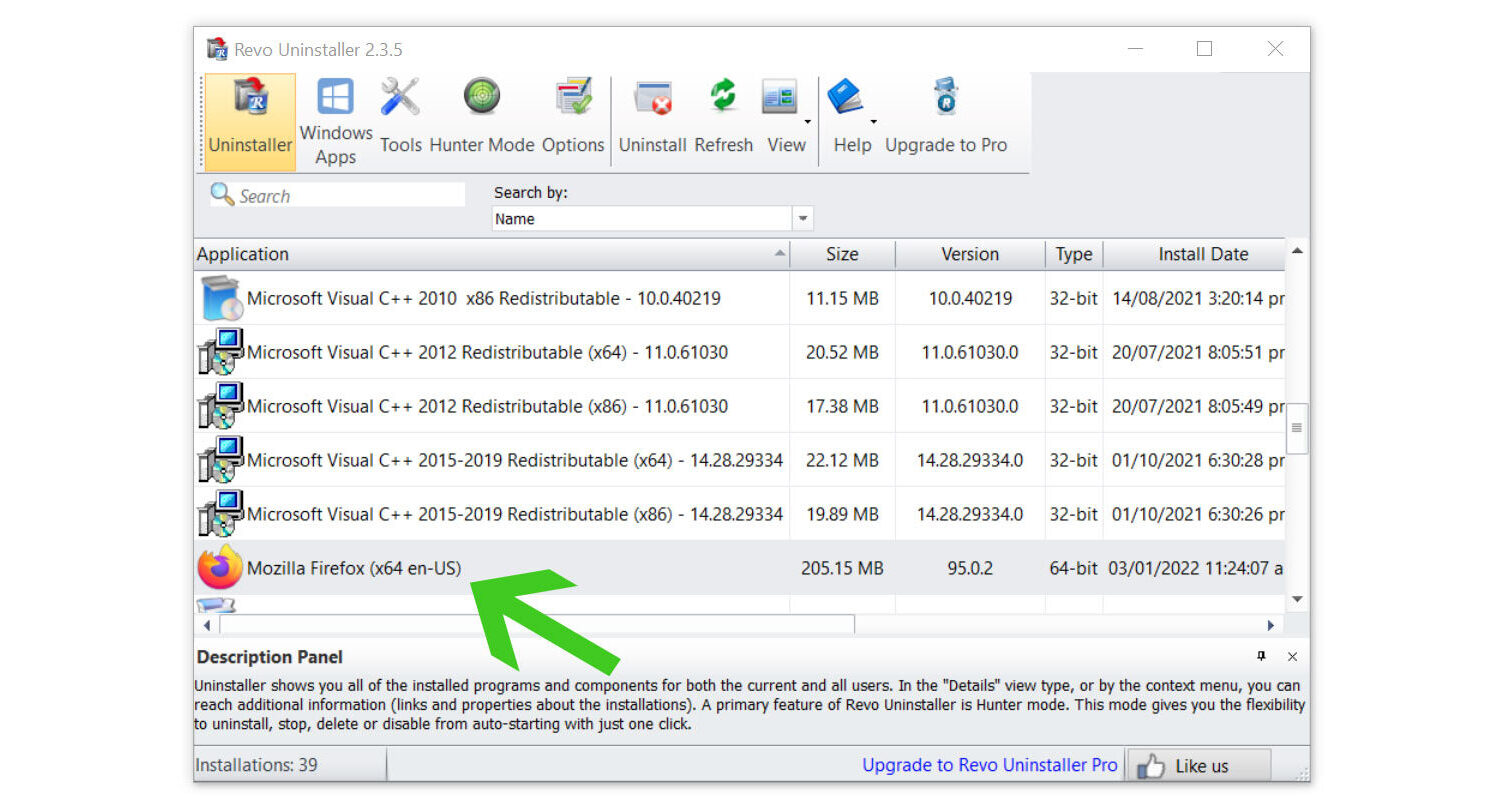
4. Click on the Continue button and follow the procedure to start uninstalling the program. It is also advised to make sure that a System Restore Point is made before the uninstallation, just in case.
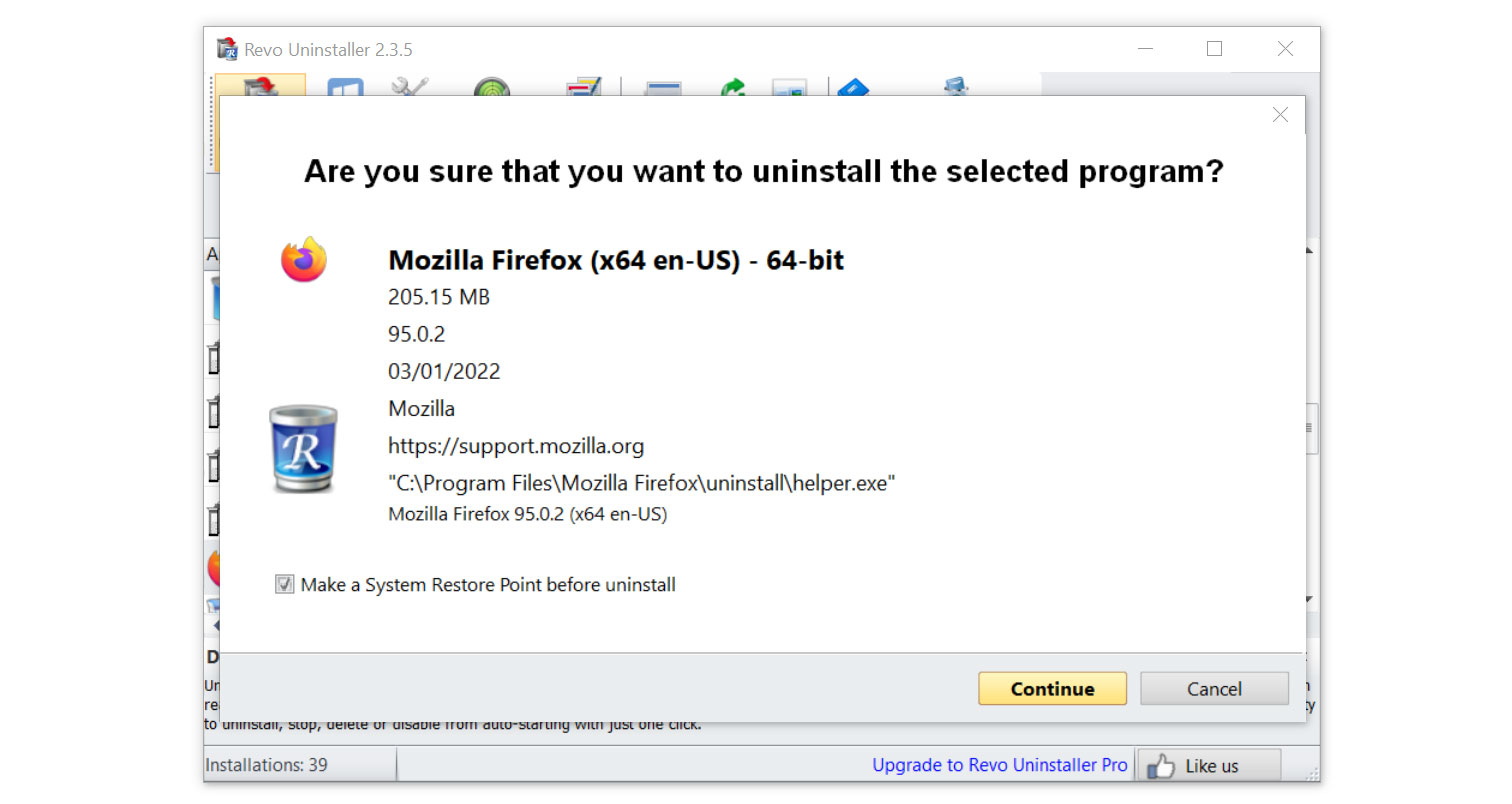
5. You will be prompted to choose a scanning mode. From the three options available, select Advanced mode, then click Scan.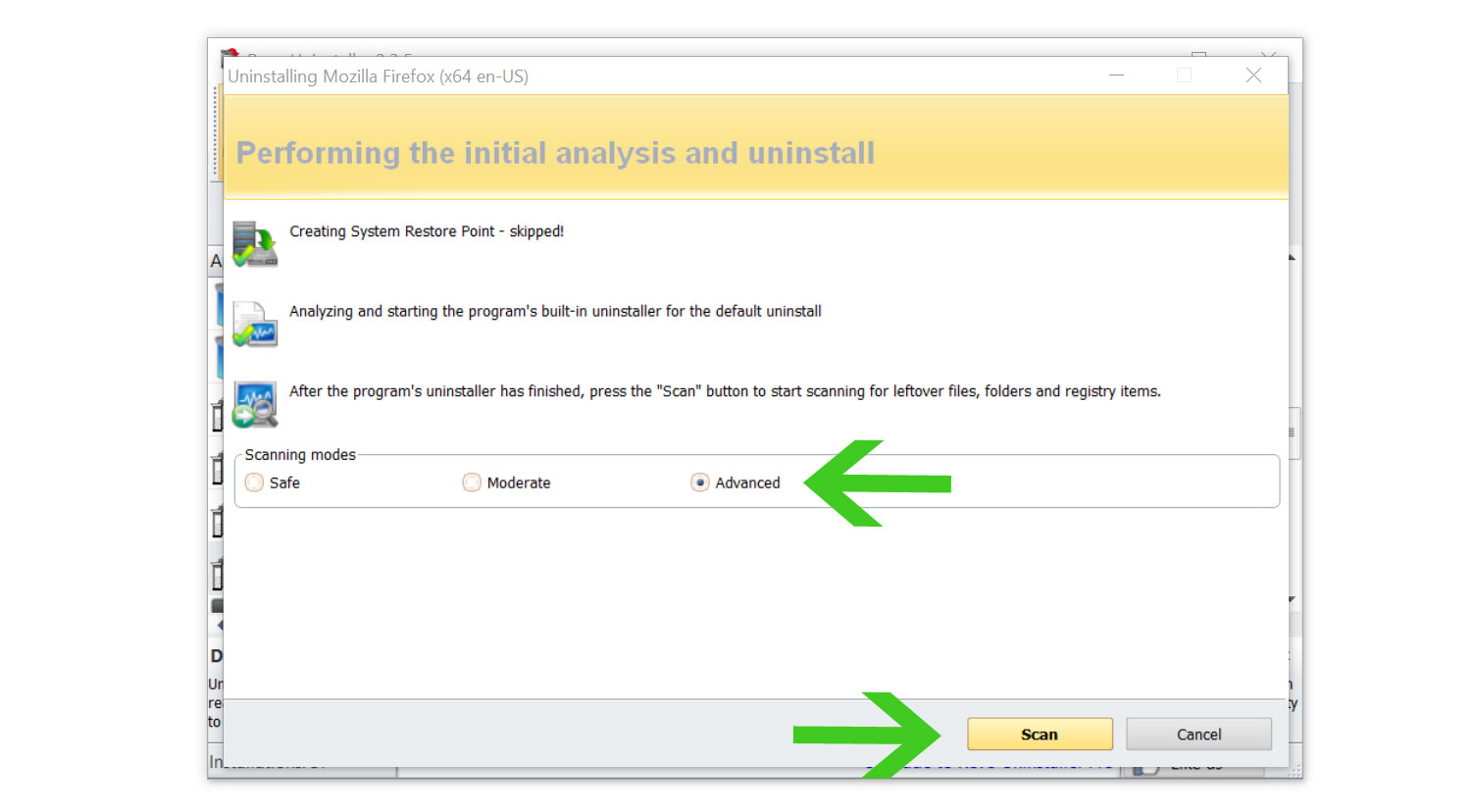 6. A window will pop up and show all of the leftovers and changes made by the uninstalled program. Click the Select All button and hit Delete to remove the leftovers found in the Windows Registry.
6. A window will pop up and show all of the leftovers and changes made by the uninstalled program. Click the Select All button and hit Delete to remove the leftovers found in the Windows Registry.
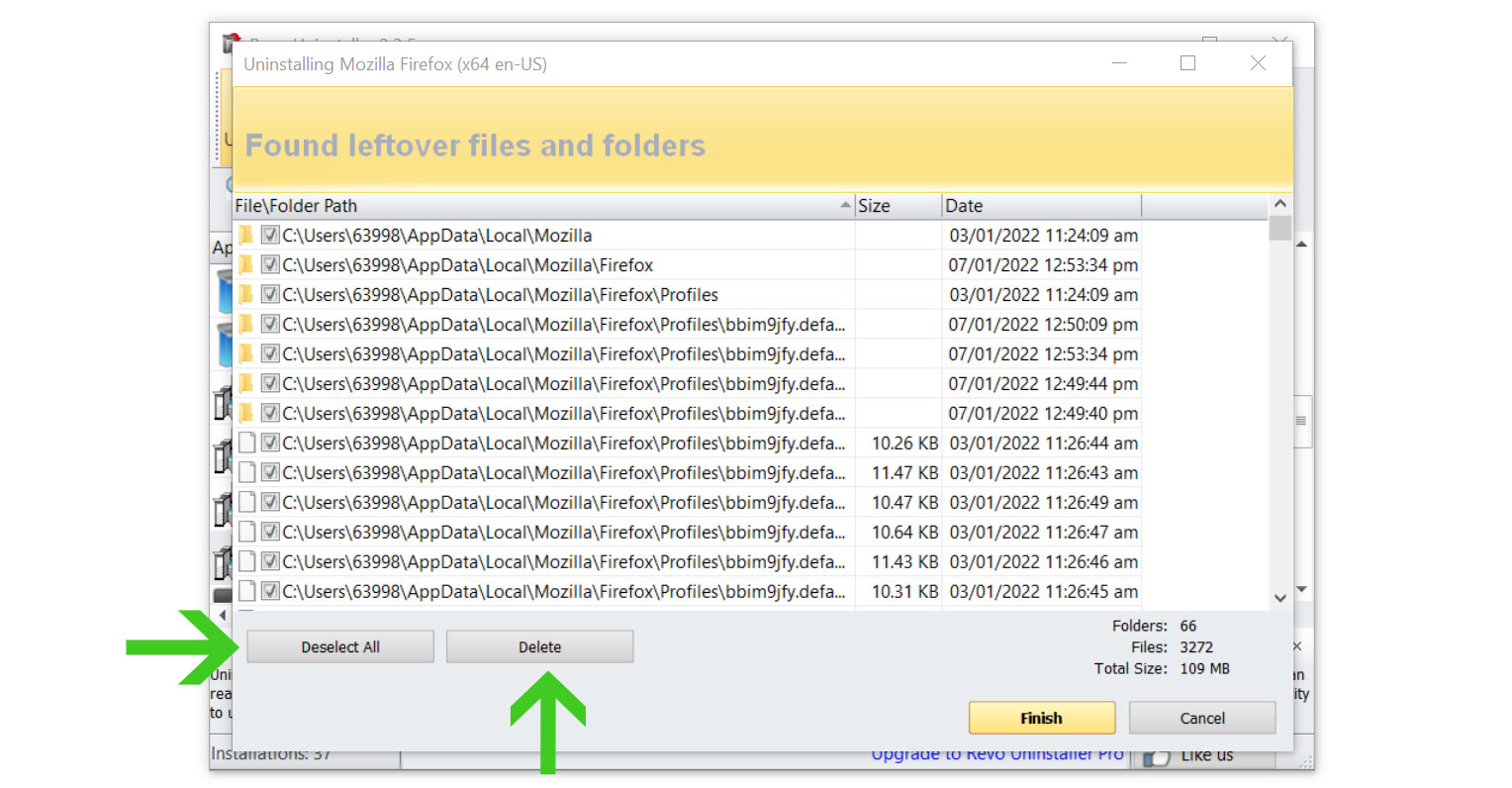
Once the window closes, you have successfully removed the malware threat from your system. And we believe with absolute certainty that once the malicious program has been removed, the browser issue will now be fixed, and you can now continue browsing the web with ease and comfort.
Step 3: Scan with powerful malware removal software
Browser hijackers may only seem to impact the web browser, but leaving it there makes the symptoms worse and could soon infect the computer as a whole. Not to mention, sensitive data can also be stored in the browser, which can be stolen by cybercriminals.
Highly damaging malware could have been installed on the computer. They can conceal themselves within the system files and registry, making them resistant to browser reset and software uninstallation.
For these virus threats, we recommend running a full system malware scan with Malwarebytes Anti-Malware. This program is widely known and recognized by security experts when it comes to removing viruses from the system.
Remove browser hijacker with Malwarebytes Anti-Malware
We have also been using this software on our systems ever since, and it has always been successful in detecting viruses. It has blocked the most common browser threats as shown from our tests with the software, and we assure you that it can remove the browser hijacker as well as other malware hiding on your computer.
 Not to mention, it is free to use and does not come at any cost to remove the viruses it finds on your computer.
Not to mention, it is free to use and does not come at any cost to remove the viruses it finds on your computer.
To use Malwarebytes and remove malicious threats from the computer, follow the steps below:
1. Download Malwarebytes by clicking the button below, as we have made an additional and in-depth tutorial on how to use it. Otherwise, you may go to their official website via Malwarebytes.com (Avoid misspelling as it may lead to scams).
Download Malwarebytes Anti-Malware
2. Visit their download section and start a Free Download to begin installing the software on your computer. 3. Once the Malwarebytes setup file (MBsetup.exe) has finished downloading, open the executable file in File Explorer, then right-click the setup and select run as administrator to give the highest system authority and make sure Malwarebytes is installed correctly.
3. Once the Malwarebytes setup file (MBsetup.exe) has finished downloading, open the executable file in File Explorer, then right-click the setup and select run as administrator to give the highest system authority and make sure Malwarebytes is installed correctly. 4. Make sure to carefully follow the installation setup wizard’s instructions and provide the relevant information it requires. You will be prompted with questions such as Personal or Business Use, Email Address, and others.
4. Make sure to carefully follow the installation setup wizard’s instructions and provide the relevant information it requires. You will be prompted with questions such as Personal or Business Use, Email Address, and others. 5. From the application’s home screen, go to the scan tab and begin running a system scan. This will scan the whole computer, including memory, startup items, the registry, and the file system. This is done so that not only the browser hijacker but also other trojan viruses hiding in the system can be detected.
5. From the application’s home screen, go to the scan tab and begin running a system scan. This will scan the whole computer, including memory, startup items, the registry, and the file system. This is done so that not only the browser hijacker but also other trojan viruses hiding in the system can be detected. 6. Since it can take a while, you should either relax and wait for it to finish or find something else to do. The length of the scan depends on the size of the files you have and the hardware capabilities of your computer. Here are some ways to make scanning faster.
6. Since it can take a while, you should either relax and wait for it to finish or find something else to do. The length of the scan depends on the size of the files you have and the hardware capabilities of your computer. Here are some ways to make scanning faster.
7. Once the scan is finished, Malwarebytes will show the malicious viruses and threats it found on your PC. The browser hijacker will also show up on the detection results, and it will be given a threat name such as Generic.Trojan.Injector.DDS, and many more. 8. Select all the detected files from the report and click the quarantine button to remove the malicious items from the computer into the protected safe quarantine zone of the anti-malware program so that they would not affect and do malicious actions on the PC again.
8. Select all the detected files from the report and click the quarantine button to remove the malicious items from the computer into the protected safe quarantine zone of the anti-malware program so that they would not affect and do malicious actions on the PC again. 9. After placing the virus files in the program’s quarantine, it may prompt you to restart the computer to finalize the full system scan procedure. Please restart your computer if prompted, as it is essential. After the restart, Malwarebytes will open and display a message that the scan was complete.
9. After placing the virus files in the program’s quarantine, it may prompt you to restart the computer to finalize the full system scan procedure. Please restart your computer if prompted, as it is essential. After the restart, Malwarebytes will open and display a message that the scan was complete.
Note: Don’t forget to delete the quarantined files afterward.
Simply quarantining the malware files is not enough to make sure they are completely removed. This is a very common misconception: once you click the quarantine button, it is all good and gone.
But, while its effects and harmful activities are halted, the malware is still in the system, only placed in the anti-malware program’s quarantine folders. To completely remove it from the computer, go to Detection History from the home screen, select all Quarantined items, and click Delete.

You have successfully removed the browser hijacker as well as the hidden threats on your computer. Rest assured they would not resurface again since Malwarebytes offers a premium trial for 14 days, so you could take advantage of it for free and prevent malware from infecting your system.
While the detection and removal of malware is free for Malwarebytes, the premium versions include real-time protection that ensures your computer is safe all the time. Although we encourage you to use the premium trial, you are free to purchase the full version if you find it useful.
The program is anti-malware that removes harmful threats like trojan horses, worms, stealers, miners, keyloggers, and many other forms of malware and computer viruses.
We suggest Malwarebytes if you are looking for a removal tool and as a second opinion scanner, but if you want full-fledged antivirus software, we believe that the built-in Windows Defender is sufficient for computer security, or if you want something with a more sophisticated system and better protection: Kaspersky Free.
If you choose to uninstall Malwarebytes, you may suddenly see that Windows Defender Real-Time Protection is turned off. This is a common issue that users may face when uninstalling the software. To fix this issue, you may refer to this article.
Alternative: Kaspersky Free Antivirus
After removing the hijacker and other malicious threats, you may want to install antivirus software to protect your system against malware.
More importantly, running an additional scan with a different program’s threat database will alert you to hidden Trojan viruses and rootkits that were not removed from the prior scan with Malwarebytes. Kaspersky is a widely known antivirus software that has been on the market for as long as the field of cybersecurity has existed. It is acclaimed by professionals in the field and is one of the most effective antivirus programs available. With its advanced internet security protection, it can also remove additional malware from the computer.
Kaspersky is a widely known antivirus software that has been on the market for as long as the field of cybersecurity has existed. It is acclaimed by professionals in the field and is one of the most effective antivirus programs available. With its advanced internet security protection, it can also remove additional malware from the computer.
What is the difference between anti-malware and antivirus? Anti-Malware software is designed to specifically remove malware and its variants. In addition, it employs heuristic-based detection by picking up harmful code from files.
On the other hand, an antivirus uses signature-based detection, which examines data for attacks to protect users from dangerous viruses, including keyloggers, loaders, worms, trojans, and others.
Malwarebytes and Kaspersky are identical, but Kaspersky is a better overall program since Malwarebytes’ main purpose is to remove malware, but Kaspersky has been known for comprehensive computer security protection ever since.
 Based on our experience removing malware, when two different programs are used to scan, various threats are identified by one software but not by the other. Given that their threat databases differ from each other, it might be able to capture harmful viruses, rootkits, and trojans that Malwarebytes has missed.
Based on our experience removing malware, when two different programs are used to scan, various threats are identified by one software but not by the other. Given that their threat databases differ from each other, it might be able to capture harmful viruses, rootkits, and trojans that Malwarebytes has missed.
Please be aware that if you decide to use Kaspersky, you should first uninstall Malwarebytes because having both security programs installed will cause a conflict. If you choose to do so, please remove Malwarebytes first, as it is essential to do so before we get started.
1. Click the button below to start downloading Kaspersky Antivirus on your computer. On the following page, we have provided clear details on how to install it on the computer. On the other hand, you may go to their official website by searching for the software on your web browser or typing Kaspersky.com (Beware of misspellings since cybercriminals typically use these as exploits to redirect users to malicious webpages).
2. Go to the download page for Kaspersky Free Antivirus. Before clicking download, you will be prompted to choose your continent and where your country is located. This is very important, and you should not choose a different country because you will be met with a “Not supported in your region” message during installation. 3. Once you click download, a setup file (startup.exe) will be downloaded on the computer. After it has finished downloading, open its file location, right-click the executable file, and then select Run as administrator. This will ensure that Kaspersky’s installation will be smooth and will not result in certain errors.
3. Once you click download, a setup file (startup.exe) will be downloaded on the computer. After it has finished downloading, open its file location, right-click the executable file, and then select Run as administrator. This will ensure that Kaspersky’s installation will be smooth and will not result in certain errors. 4. The Kaspersky installation wizard will launch, and you can then proceed to install Kaspersky Free by following the setup instructions. If a UAC prompt appears, simply accept it and proceed with the installation.
4. The Kaspersky installation wizard will launch, and you can then proceed to install Kaspersky Free by following the setup instructions. If a UAC prompt appears, simply accept it and proceed with the installation. 5. Please be patient while Kaspersky is being installed on your computer. The speed and length of the installation process will depend on your computer’s specifications. Kaspersky also mentioned that sluggishness or dark displays during the installation of their program are normal and should not be worried about.
5. Please be patient while Kaspersky is being installed on your computer. The speed and length of the installation process will depend on your computer’s specifications. Kaspersky also mentioned that sluggishness or dark displays during the installation of their program are normal and should not be worried about.
6. To use the antivirus program, you must first create an account on the sign-in page that appears after the antivirus application has been successfully installed on the computer. If you’re looking for the sign-up button, simply enter your email exactly as it appears; if you don’t already have an account, one will be created for you. 7. Kaspersky will ask you to decide which plan to use. It will be either the Standard version or Kaspersky Plus. In this case, the standard version is all you need for now. If you want to try the premium version of Kaspersky, you may opt for Kaspersky Plus to try the features for free. You do not have to add a payment method to get started, and after the trial ends, you will be downgraded to the Standard version unless you pay for it.
7. Kaspersky will ask you to decide which plan to use. It will be either the Standard version or Kaspersky Plus. In this case, the standard version is all you need for now. If you want to try the premium version of Kaspersky, you may opt for Kaspersky Plus to try the features for free. You do not have to add a payment method to get started, and after the trial ends, you will be downgraded to the Standard version unless you pay for it. 8. You will be asked if you want to install additional applications, namely Kaspersky Password Manager and a VPN. Feel free to opt for a program you might want to use; otherwise, install both, or choose not to if you do not need them.
8. You will be asked if you want to install additional applications, namely Kaspersky Password Manager and a VPN. Feel free to opt for a program you might want to use; otherwise, install both, or choose not to if you do not need them. 9. Kaspersky will ask you to scan for viruses in the background. Simply choose not to do so because we will be doing a full system scan later; however, doing a scan now will only initiate a quick scan. However, if you want to be safe, you can run the background scan now and proceed with a full system scan after.
9. Kaspersky will ask you to scan for viruses in the background. Simply choose not to do so because we will be doing a full system scan later; however, doing a scan now will only initiate a quick scan. However, if you want to be safe, you can run the background scan now and proceed with a full system scan after. 10. Once the antivirus application has opened, go to the security tab and click the choose a scan button. You will be presented with several different scans; go for the full system scan to ensure full computer security. Always remember to update the database because this will ensure that Kaspersky can detect newly discovered threats and exploits.
10. Once the antivirus application has opened, go to the security tab and click the choose a scan button. You will be presented with several different scans; go for the full system scan to ensure full computer security. Always remember to update the database because this will ensure that Kaspersky can detect newly discovered threats and exploits. 11. A full system scan will take a long time to finish since it will look into all the files on the computer, including the registry, memory, startup applications, and many more. The scanning time will depend on how many files there are on the computer and how big the files are. Additionally, the computer’s hardware and specs will also play into how long the scan will take.
11. A full system scan will take a long time to finish since it will look into all the files on the computer, including the registry, memory, startup applications, and many more. The scanning time will depend on how many files there are on the computer and how big the files are. Additionally, the computer’s hardware and specs will also play into how long the scan will take.
12. After the full system scan is finished, it may detect remnants of the hijacker or other malware hiding in the computer, showing its location along with a detection name (Trojan.Win32.Generic, Exploit.Win32.Generic, etc.) given to it. Go ahead and proceed to disinfect and restart the computer. 13. The Advanced Disinfection process will then start, and depending on the amount of RAM the computer has, it could take some time. It will then request a computer restart to complete the operation.
13. The Advanced Disinfection process will then start, and depending on the amount of RAM the computer has, it could take some time. It will then request a computer restart to complete the operation. Your computer will now have finished the entire system scan after restarting. By doing this, you can be sure that the browser hijacker and all other forms of malware and viruses have been wiped from your computer.
Your computer will now have finished the entire system scan after restarting. By doing this, you can be sure that the browser hijacker and all other forms of malware and viruses have been wiped from your computer.
You shouldn’t be concerned if the scan turned up no instances of malware or viruses, which indicates that there isn’t any malware on your computer. If two independent programs declare your computer safe, then that’s probably the case.
For a better and safer web browsing experience, we’ve provided a few security measures and advice below that will safeguard your browser and computer from harmful threats like worms, malware, trojans, keyloggers, stealers, and other kinds of computer viruses that will harm user data.
Protective measures for better overall security
Removing trojan viruses and malware from the device is one thing; keeping it secure for the future and for a long period is a different thing and will require certain things to make sure you are secured, especially if you do not know most of the ins and outs of the device you are using.
Cybercriminals are always stepping up their game to make sure they infect users and extract data and money from them.
We encourage you to take the actions listed below to ensure complete security before leaving this page because we strongly promote web security and having a secure online presence.
Safeguard your data and privacy online by using a VPN application
VPNs, also known as virtual private networks, guarantee your safety and complete anonymity while you browse the internet.
In contrast to a firewall, which monitors and blocks potentially harmful connections in the network, A VPN hides the user’s connection via a tunnel so that it would appear to third parties as a different IP address and location.
This ensures that your data won’t be leaked because the program hides it. Be aware that visiting infected websites may cause your IP address and location to be disclosed; however, if you use a VPN, this will prevent your true IP address from being revealed to malware actors.
If you already had Kaspersky installed from the previous step, you had the choice to install its integrated Virtual Private Network, which is a good tool that we also advise.
However, if you decide against doing so and instead download a VPN-only program to cloak your web browsing activity, Mullvad, and AirVPN are excellent choices for fast connections and better privacy.
Mullvad VPN

Since user privacy is the main focus of a virtual private network program, Mullvad VPN excels at putting users’ privacy first. You do not need to enter your email address while registering to download their application because they maintain anonymous accounts.
If you wanted to hide or didn’t want your credit card information to be disclosed, they also accept Bitcoin payments. According to their website, they support a free internet that is devoid of surveillance and censorship.
They have also been announcing new server locations to guarantee users a fast connection anytime they want to connect to various areas throughout the world.
AirVPN
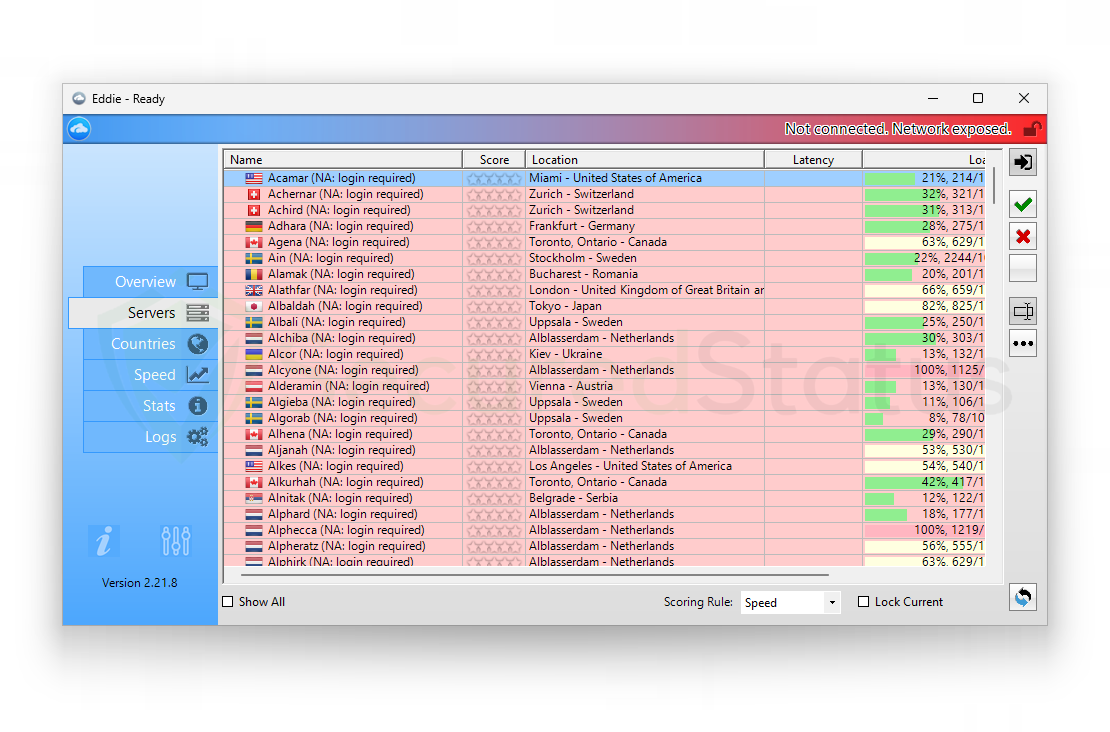
AirVPN seeks to provide users with access to the real internet, in contrast to Mullvad, which promises to offer users free internet. Along with masking your IP, they also don’t monitor or log any user data, which is good.
You can use it for a long time without worrying about being disconnected because they don’t impose a traffic or time limit when connecting to their servers. In addition, there are infinite, cost-free server changes with physically fast servers in many different nations.
Additionally, when registering for their program, you are not required to enter your email address. They also offer strong encryption and Perfect Forward Secrecy to ensure that it is difficult to determine the user’s connection.
Utilize an adblocker when browsing the internet
Installing an adblocker on the browser is the best way to prevent hijacker viruses as well as other threats such as pop-ups, redirects, and unwanted toolbars.
Additionally, by blocking malicious websites before users can even access them, it is possible to prevent malware from being downloaded.
In this case, we recommend uBlock Origin, which is an open-source AdBlock extension that comes at no cost and is free forever. It is one of the most reliable plugins out there, ensuring that every advertisement on a webpage will be blocked.

For Google Chrome
1. Go to the Chrome Web Store and search for the browser extension, or click here to go directly to the extension page.

2. Click the Add to Chrome button. Then click Add extension when the confirmation window appears.

3. uBlock Origin is now installed in Google Chrome. The adblocker is turned on by default; you can click the power button if you wish to turn it off for a while. The menu can be found by clicking the puzzle icon in the upper-right corner next to the search bar.
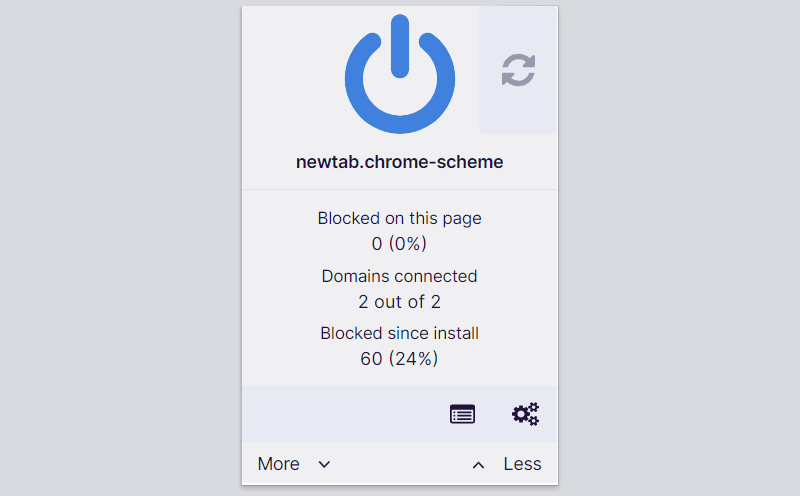

For Mozilla Firefox
1. Visit the Firefox Add-ons Store and search for uBlock Origin, or click here to automatically go to the extension’s webpage.
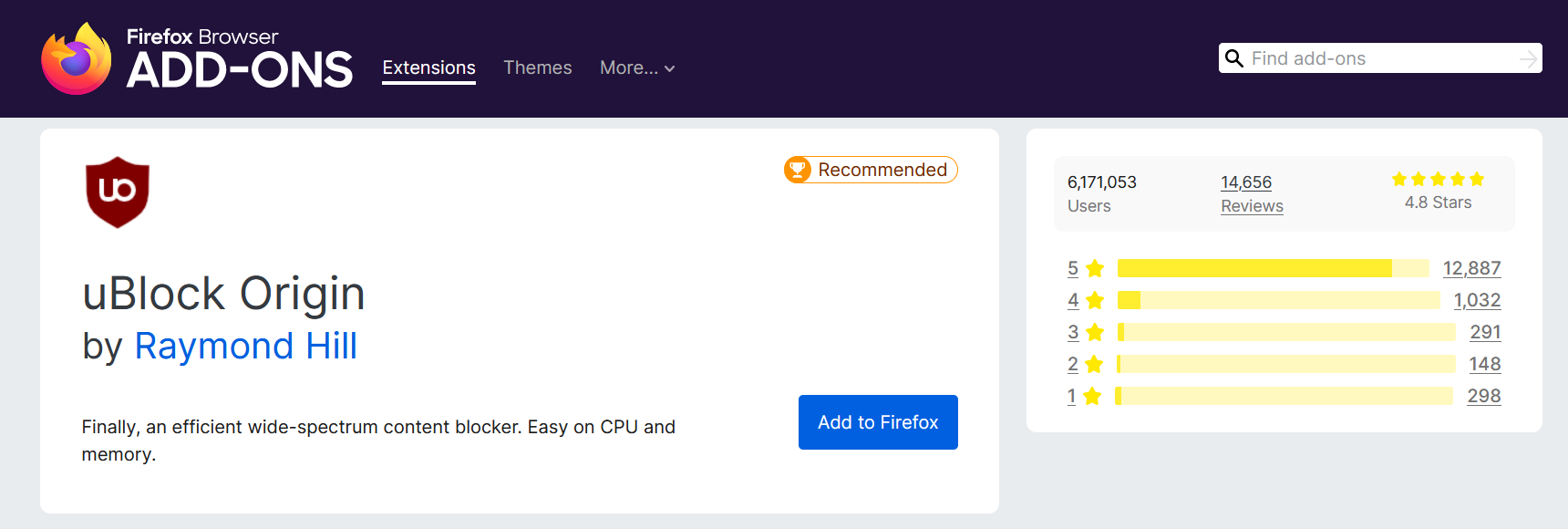
2. Click Add to Firefox, and after that, a confirmation window will appear stating the permissions it will grant the addon. Finally, to add it to the browser, click Add.

3. Mozilla Firefox now has uBlock Origin installed. The adblocker is activated by default; if you want to disable it for some reason, simply click the power button. The menu can be found in the upper-right corner of the web browser, next to the search bar.
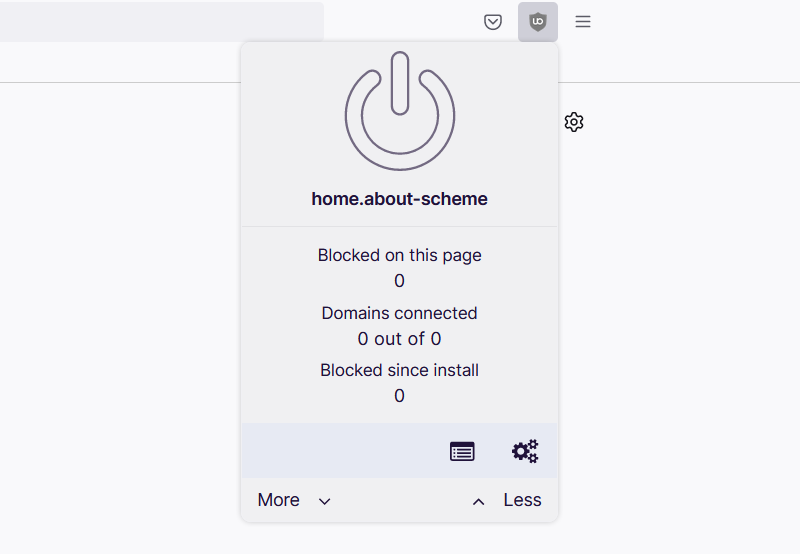

For Microsoft Edge
1. Go to the Edge Addon Store and search for the said browser extension. You can also click here to go directly to the plugin page of the Adblocker.

2. Click the Get button, and a confirmation window will appear. Continue installing the extension by selecting Add extension.

3. Now that uBlock Origin is installed on the browser, you can choose to disable the Adblocker by clicking the power button. The menu can be accessed by hovering over the extension’s icon next to the search bar.
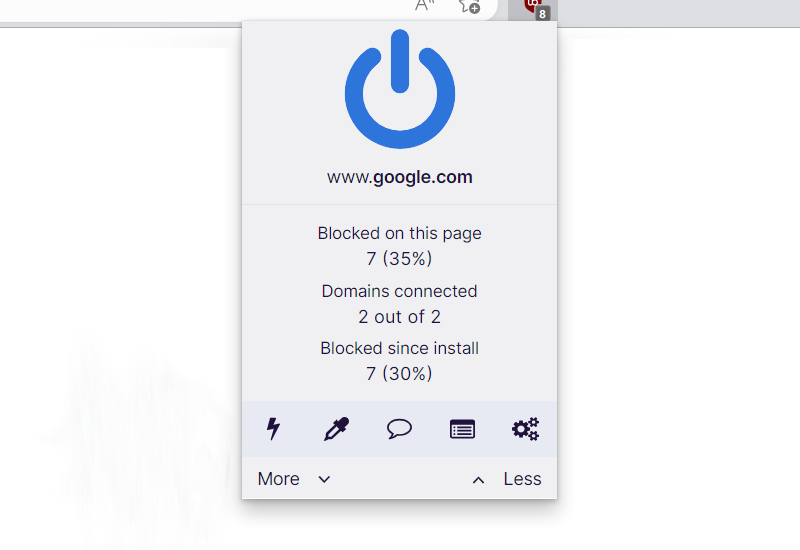
The majority of pop-up advertisements, whether they include malware or not, will be filtered by the extension and no longer be displayed to you. Currently, uBlock Origin is not available for Mac or iOS users, but there are plenty of free options on the market, such as AdBlock for Safari.
Use a firewall to prevent cyber attacks
A security firewall is required for every internet connection that is made. It is an essential tool that enhances security and stops online attacks.
Through a security mechanism, it controls incoming and outgoing network connections on your system and network and filters the undesirable ones. Consider it a further barrier against malicious assaults and zero-day exploits.
You don’t need to do anything if you installed Kaspersky in the previous step because the program we installed earlier comes with a built-in firewall that is turned on by default.
On the other hand, if you prefer a standalone, fully functional firewall utility application that is exclusively focused on securing the network, we recommend these top two firewall solutions for personal computers: Comodo and ZoneAlarm.
Comodo Personal Firewall

Comodo Firewall is a well-known software program for securing your network and computer. It is a sophisticated tool with a wide range of features.
It is simple to use and doesn’t require complicated configuration to set up. It also functions by being aware of your computer usage habits to avoid interfering with your work.
In addition to that, it also claims to offer the highest levels of protection against both inbound and outbound threats. It secures the ports on your computer from hackers and prevents rogue software from sending your sensitive data over the internet.
ZoneAlarm Free Firewall
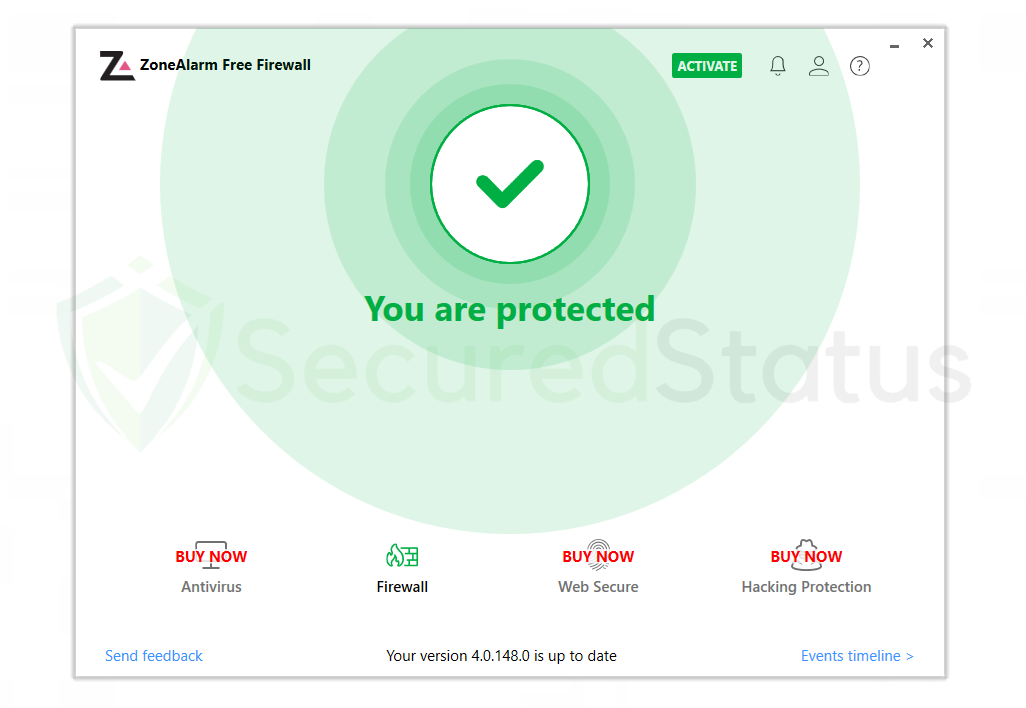
You can also opt for ZoneAlarm Free Firewall as your first line of defense between your device and the internet. The program safeguards your network and blocks any dangers, and you can use the free version of it without paying anything.
It provides a robust two-way protection solution that guards against spyware from disclosing your data online while also hiding your PC from nefarious hackers.
With its cutting-edge anti-bot protection, it also protects your computer from automated cyberattacks in real-time.
Additionally, it protects your computer against spam and dubious websites. Lastly, it provides real-time defense against automated cyberattacks with its cutting-edge anti-bot security.
Bottom Line
While this may appear to be typical advice, we recommend users not visit illegal streaming or torrenting websites and more importantly, do not download anything from them because doing so may result in the installation of malware and viruses.
Because these websites are illegal, they are unable to make a profit from legitimate advertising. As a result, they host questionable advertisements from unidentified marketers that want to publicize their contents, which are most likely dangerous codes being propagated by cyber criminals.
Always make sure that your device is protected against sneaky exploits and stealthy cyberattacks. While taking precautions and avoiding dubious websites are crucial, having a solid line of defense is essential to ensuring the security of your network and data.
The threat posed by browser hijackers is not the only one on the internet, and there are many more surfacing every day. We are glad to have assisted you in resolving your browser-related problem and are proud of our expertise in this area.
If you experience another virus attack on your device, please visit our website to find a malware removal solution for your problem or get in touch with us, and SecuredStatus will be happy to assist you once again.

